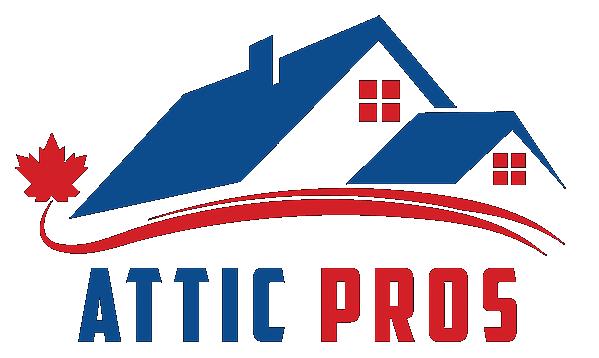Vantage Jewellers


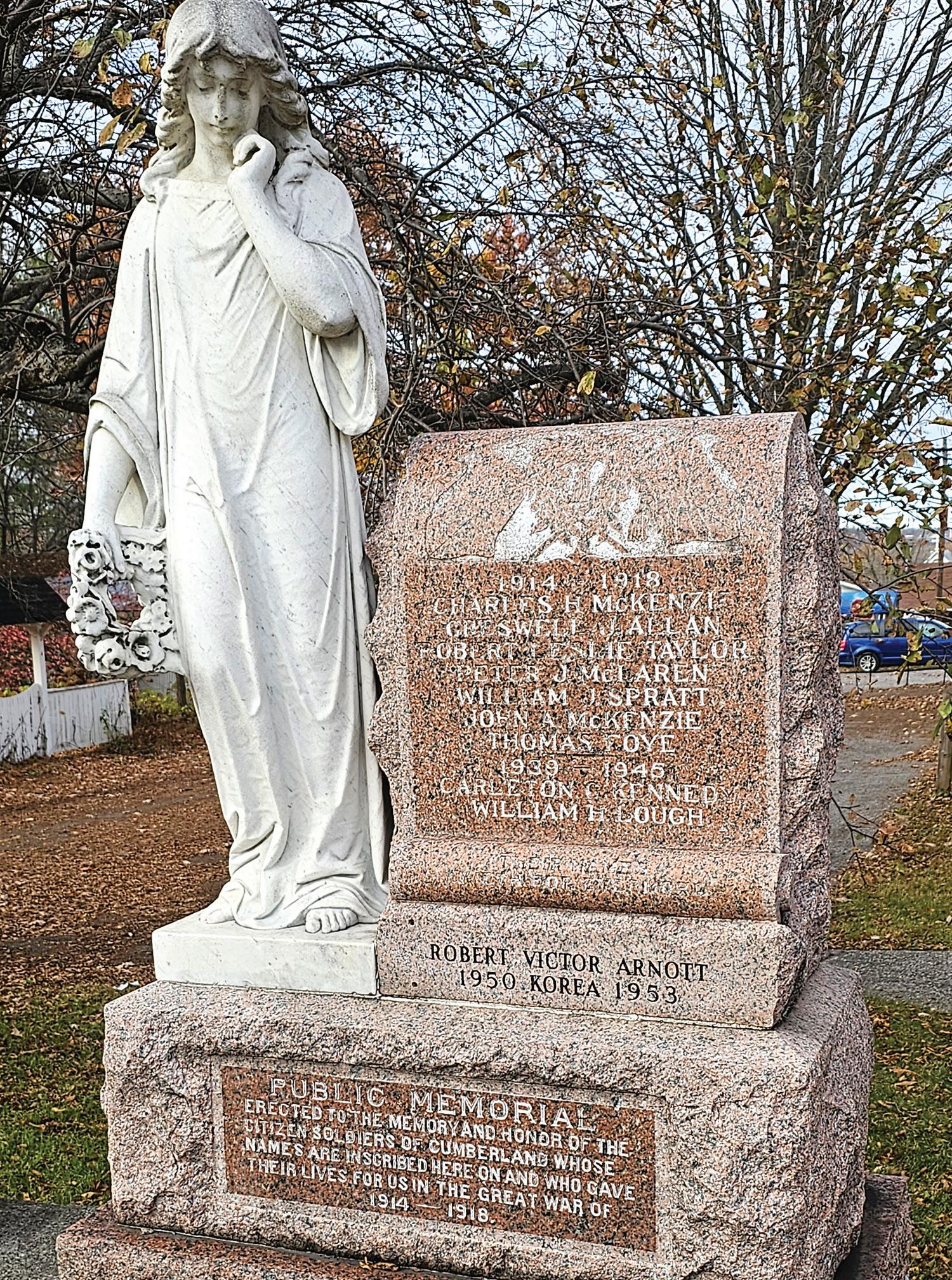




By Fred Sherwin The Orléans Star
The former township of Cumberland has a long history of service to their country starting with the First World War when many young men left their family farms to join the Canadian Expeditionary Force. Most saw service in the Royal Canadian Artillery, where they were responsible for moving the heavy guns from position to position using teams of heavy draft horses such as Clydesdales and Percherons. Almost all of them would have experience working with the horses while doing plowing and other chores. In fact, a number of the local farms contributed some of their own horses to the war effort, never to see them again. All told, the Canadian Corps required over 23,000 horses during the duration of the war. Less than a dozen were returned to their owners, none of which were draft horses.
Twenty-four young men from Navan served in what became known as the Great War. Another 42 men joined from other parts of the township, including Cumberland Village, Vars and Bearbrook. A number of them never returned home.
Charles McKenzie, Cheswell Allan, Robert Leslie Taylor, Peter McLaren, William Spratt, John McKenzie and Thomas Foy, all from the Cumberland Village area, were either killed in action or died from other causes related to having to live for weeks on end in mud-filled trenches.
Thanks to Cumberland Village historian Jeannie Smith, we know a little bit about some of these men.
Charles McKenzie came to Cumberland to work on the Canadian National Railway which had opened in 1909.
CONTINUED ON PAGE 2

Continued from page 1
A tall man at 5’11”, he signed up to go overseas with the Canadian Forestry Corps on May 3, 1916. He was assigned to the 38th Battalion of Eastern Ontario and set sail with his comrades on June 2, 1917. He would end up dying from war wounds and pneumonia in an English hospital just over year later on Aug. 25, 1918.
Creswell Allan enlisted on Sept. 29, 1914 and was assigned to the 2nd Battalion Eastern Ontario, the day before his 23rd birthday. He
had been a fireman, working on the railroad stoking the engines.
Although he was only 5’5”, Creswell was strong and sturdy enough to be a stretcherbearer with the medical corp. He was fatally wounded in the head and abdomen on April 4, 2017 while carrying injured soldiers to safety during the Battle for Vimy Ridge.
Robert Leslie Taylor left the family farm and enlisted in the army on Nov. 20, 1915. He was later assigned to the 73rd Canadian Infantry of the Royal Highlanders of Canada,

also known as The Black Watch.
Less than a year after he enlisted, Robert Taylor was severely wounded in the head during the Battle of the Somme. He died in an English hospital on Feb. 13, 1917 at the age of 33.
Peter McLaren was the son of Cumberland constable Peter A. McLaren. Young Peter was a farmer who enlisted on Aug. 16, 1915 at the age of 33. He was assigned to the 77th Battalion. He was getting killed by shell fire during a raid on enemy positions near Vimy on the morning of June 9, 1917.
Private McLaren was buried at La Chaudière British Cemetery in France. His body was exhumed in 1922 and reburied in Dale’s Cemetery beside the present-day Cumberland Heritage Village Museum
Two Cumberland comrades were killed in action on Nov. 18, 1916, probably dying close to each other on the muddy battlefield at the Somme. Bill Spratt and John McKenzie were in the 38th Ottawa Battalion together.
Spratt stood a head taller than his pal John. He enlisted on Feb. 26, 1915, four days after John did.
They were ten digits apart in regimental numbers but killed nearly side by side. Bill
Spratt, dying at 27, never fulfilled his talent as a carpenter.
John MacKenzie was just 23 years old when he and his company took part in an attack on Vancouver Trench, north of Vimy. The explosion of a German shell at 6 a.m. on Nov. 18, 1916 instantly killed both himself and his friend Bill Spratt.
The Mackenzie’s family home was located at 2518 Old Montreal Rd., on the same block as the homes of Creswell Allan and Peter McLaren.
The story of Thomas Patrick Foy is tragic indeed. Neglected by both of his parents, he emigrated to Canada in May 1911 to work on the farm of Peter Larocque just east of Cumberland Village.
Foy enlisted in the army on Nov. 23, 1915, and was assigned to the Canadian Grenadier Guards 11th Brigade.
He was killed during his company’s attack and capture of Regina Trench during the Battle of the Somme, sometime between Oct. 21 and Oct. 24, 1916.
These are the stories of just some of the men from Cumberland who made the ultimate sacrifice for their country and for whom we pay homage every Remembrance Day.

By Fred Sherwin The Orléans Star
Students at Cairine Wilson Secondary School in Orléans raided their families’ cupboards and went door to door in the community last week to collect over 4,000 food items for the Ottawa Food Bank.
The Hallowe’en for Hunger food drive has been an important student-driven initiative for more than 25 years. For the past several years, it’s been organized be members of the student R.I.S.E. Club which stand for Rejuvenate, Inclusivity and Sustainability in Education.
This year’s co-lead organizers were Grade 10 students Anika Suthakaran and Mackenzie Joanisse.
The pair first joined the R.I.S.E Club last year as a way to become involved at the school while helping others.
“It’s a pretty big tradition here,” says Suthakaran. “And we both really wanted to take the lead in co-organizing the drive this year.”
Suthakaran and Joanisse led a team of more than 40 of their fellow students in collecting and organizing the food donations.
They had even more help when it came to packing the more than 4,000 items in boxes and loading it on to the Ottawa Food Bank trucks last Friday.
“It was really nice to see how much people really cared and wanted to help, especially in the rainy weather, because it made it a lot harder to collect the food,” says Joanisse
It took several hours to load all the food on to the truck which had to make two trips to the Food Bank’s warehouse.
“Just seeing the truck being filled was a really big deal for me, knowing that our contribution will help so many people,” says Suthakaran.
The food items will be distributed to community food banks around the city depending on the need.
Ottawa-area food banks have seen a significant increase in demand this year, which has mirrored a similar situation across Ontario and the entire country, which is on top of a record increase in demand in 2024 when over one million Canadians had to rely on their local food bank for emergency food supplies at some point during the year.
According to the Ottawa Food Bank,

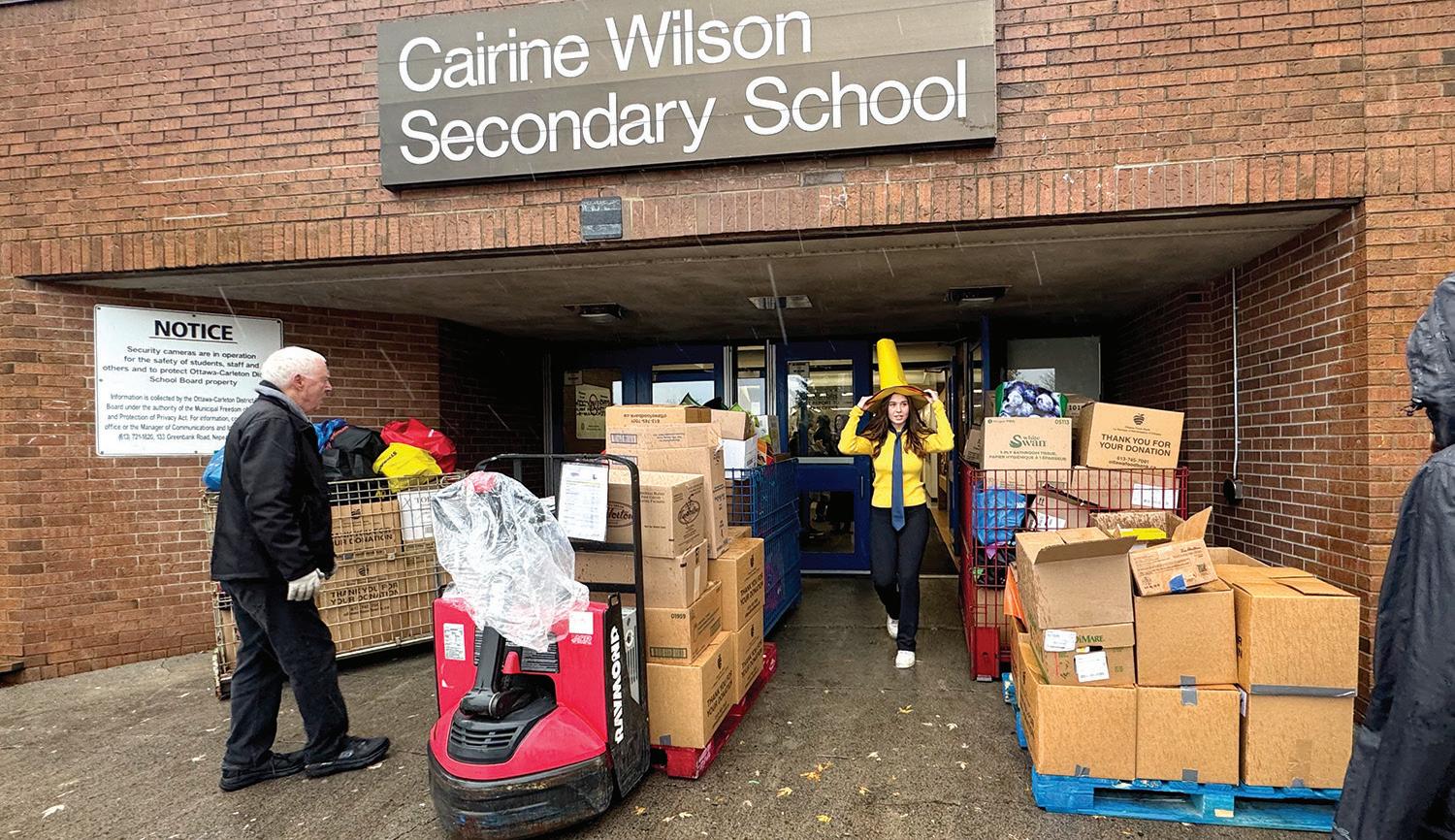
Food donations sit outside Cairine Wilson Secondary School waiting to get loaded on to a truck bound for the Ottawa Food Bank.
food bank usage in the city is up by 90 per cent since 2019, and the number of Ottawa households that struggle to afford food nearly doubled between 2022 and 2023. And while there are no official figures available yet for 2025, the number of people who are calling on their food bank for help has continued to rise, according to the people
who handle the day-to-day operations of the food banks.
If you would like to make a contribution to a food bank in our area, you can contact either the Gloucester Emergency Food Cupboard, the Orléans Cumberland Community Resource Centre food bank, or the Community Compassion Centre food bank.






“Service above self” just happens to be the motto of the International Rotary movement, but it also best describes the volunteer members of service clubs everywhere.
Service clubs present a perfect opportunity for ordinary citizens to serve their community in a selfless manner while also providing an opportunity to meet other like-minded people.
Orléans is blessed with a number of excellent service clubs which are more than happy to welcome new members. The Rotary Club of Orléans, the Optimist Club, the Kin Club of Orléans, Kiwanis Eastern Ottawa Est and Lions Club chapters in Orléans, North Gloucester, Navan and Cumberland, all have a long history of serving their community.
The Rotary Club of Orléans is part of Rotary International which is a worldwide organization made up of more than 1.2 million business, professional and community leaders. Among their many initiatives and activities are the Ottawa Rotary Youth Forest, the Orléans Rotary Youth Awards and the semi-annual Fallingbrook Park Cleanup. They also organize a number of fundraising events to help raise money for Rotary programs such as the International Student Exchange program.
As the name suggests, Kiwanis East Ottawa Est is a global community of clubs, members and partners dedicated to improving the lives of children one community at a time.
Among their many initiatives and activities are the O Canada celebration on Petrie Island and the sKreamers haunted attraction at the Proulx Farm. They are also the founders and custodians of the Kiwanis Adventure Playground at Millennium Park in addition to being the founding partner of the World Trivia Night event which benefits the Children’s Aid Society of Ottawa.
One of the main purposes of the area Lions Clubs is to take an active interest in the civic, cultural, social and moral welfare of the community. The clubs are involved in a number of fundraising activities in the various communities they serve such as the Navan Fair, the Canada Day Seniors Bingo, the A4 District Memorial Forest, and the Blind Anglers Tournament. Among the initiatives they support are the Eye Glass Recycling Program, Camp Banting, and service dog training.
Although not as large in numbers as the other area service clubs, the Optimists International has chapters in Orléans, Blackburn Hamlet, Beacon Hill and Carlsbad Springs and like the Kiwanis Club they mainly support and organize youth initiatives.
As you can see, there are a number of clubs you can join to both help support your community and expand your connections and friendships. Just do a little research and pick the one you feel most comfortable in joining.
– Fred Sherwin

Jody Maffett Editor
The Orléans Star
Fred Sherwin Owner and publisher fsherwin@orleansstar.ca
Jean-Marc Pacelli Editor L’Orléanais
The Orléans Star is a bi-weekly publication distributed to over 40,000 residences in Blackburn Hamlet, Orléans and Navan. The newspaper is locally owned and operated by Sherwin Publishing Inc., 745 Farmbrook Cres., Orléans, ON. Inquiries and delivery issues should be sent to info@orleansstar.ca.

Every year, on the eleventh hour of the eleventh day of the eleventh month, our community gathers to pause, to remember, to reflect, and to give thanks. We stand in silence not only for those who made the ultimate sacrifice, but also for those who continue to serve and for the families who stand beside them every day.

Here in Orléans, Remembrance Day holds a special meaning. Our community is home to one of the largest populations of active and retired Canadian Armed Forces members in the country. It’s no wonder some affectionately call our community “CFB Orléans.”
From the veterans at the Legion to the spouses and their families who hold it all together during deployments, service and sacrifice are part of the fabric of our community.
When we think of remembrance, it is easy to picture the solemn ceremonies, the wreaths and poppies, and the sound of the bugle. But remembrance must be more than a moment of silence. It must be an act of gratitude lived every day: in how we support our veterans, in how we care for their families, and in
how we teach our children about the freedoms that were bought at such a great cost.
The young men and women who left home to serve did so believing in something bigger than themselves; a belief in democracy, in peace, in the idea that Canada could be a force for good in the world. Many never came home. Others returned with wounds, visible and invisible. All deserve our thanks, our respect, and our commitment to never forget.
On November 11, I’ll be proud to stand shoulder to shoulder with veterans, families, and residents at the Orléans cenotaph to honour that promise. I invite you to do the same To pause, to remember, and to reflect on the incredible courage and selflessness of those who served and those who continue to serve.
To the men and women of the Canadian Armed Forces and to the families who serve beside them, thank you. Your sacrifice reminds us that freedom is not free, and that the strength of our nation is measured not only on the battlefield, but in the compassion of its people.
Lest we forget!
Is there any ride that has as many ups and downs on a person’s psyche than being the fan of a professional sports team?
I’m asking this question in the immediate aftermath of the Toronto Blue Jays loss to the Los Angeles Dodgers in Game 6 of this year’s World Series.
I was hoping to write about how the Jays beat the odds in yet another series to win the whole shebang for the first time in 32 years.
In fact, up until Addison Barger got caught trying to scramble back to second base on a bullet throw from Dodgers’ outfielder Enrique Hernandez for the game-ending double play, I still thought they had a shot to win the game and the series. But they didn’t, which set up the winner-take-all game on Saturday.
Unfortunately, because this paper goes to press on Saturday afternoon, I have no clue on the outcome of said Game 7.
If they won...woohoo. It’s been hard not to cheer for the Jays this post-season. They are a tight knit group who seem to truly love the game they get paid millions to play and they seem to really love and appreciate each other.
Even though the Jays winning would back
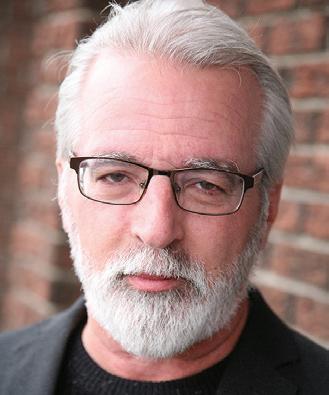
Torontonians even more unbearable than they already are, it’s a small price to pay for winning America’s favourite pastime and bringing the trophy north of the border.
I just wish I could have been there in person, if that in fact, is what happened. There’s nothing quite like being a part of that atmosphere, unless of course they lost.
The last time the Jays were in the World Series was 1993. My buddy Kevin and I went to Game 2 at the Skydome, hoping to see them win against the Philadelphia Phillies and take a 2-0 series lead. Instead, they gave up five runs in the second inning and ultimately lost 6-4 after giving up an insurance home run in the seventh that landed three rows in front of us.
I believe we paid a scalper $400 each for
the tickets that were midway up the outfield bleachers.
The five-run burst in the second inning completely took the air out of the place and watching the rest of the game was no different than watching a game in mid-July.
The four-hour drive back to Ottawa was even more deflating than the actual game.
The Jays would go on to win the series on Joe Carter’s legendary walk off home run in Game 6, but of course, we weren’t there for that epic moment in sports history. We had already blown our budget on the tickets to Game 2.
That’s the problem with best out of seven or best out of five series. You have no idea if your team is going to win any one particular game. Your only insurance is to go to every home game and hope they win. That’s why you’re much better off going to something like the Grey Cup or the Super Bowl – if you don’t mind taking out a second mortgage to buy a ticket.
Anyway, where was I? Oh yes, the World Series and Game 7 in particular.
If the Jays did win Game 7, I’m sure the aprés party was outstanding.
Canada and Canadians haven’t gotten
behind a team like this since the Toronto Raptors won the NBA championship in 2019, or the 2010 men’s Olympic hockey team that won gold in Vancouver on Sidney Crosby’s epic overtime goal.
And we should savour every minute of it, assuming we won, because it doesn’t happen very often. The Jays haven’t won the World Series since 1993 and they’ve only won it twice in the 48-year history of the franchise, which also happens to be the same number of times they’ve been in the World Series.
The Raptors have only been to the NBA finals once in their 40-year history. And a Canadian team hasn’t won the Stanley Cup since 1993 when the Montréal Canadians beat the Los Angeles Kings.
Closer to home, the Ottawa Senators have only made the NHL finals once in their 33year history and they broke every fan’s heart when they lost in seven games.
You’re more likely to see a total eclipse of the sun than you are to see a Canadian team win a professional sports crown.
So here’s hoping the Jays won on Saturday, and if they didn’t, here’s hoping we don’t have to wait another 32 years to get another kick at the can.



(Editor’s note: Last week, we mistakenly ran the wrong column for Coun. Kitts. The intended column is contained herein. The Orléans Star wishes to apologize to Coun. Kitts and its readers for any inconvenience this may have caused.)

You may have seen the recent news about the Return-to-Office vote at council. I could not support a motion that endorsed the city manager’s position on a five-day return-to-office standard. While I appreciated that the policy has since been adjusted to allow for hybrid flexibility, thanks in large part to public feedback and councillor advocacy, I believe the decision was poorly communicated from the outset and in need of a strategic rethink.
My concern goes beyond this single policy. If the federal government and other major employers follow suit with full-time in-office standards, I believe our already strained transportation system, especially in Orléans South, will be pushed beyond its limits. For years, I’ve been sounding the
alarm that the pace of suburban development is far outstripping investment in transportation infrastructure. Without a stronger plan, we risk walking straight into a commuting disaster we should have seen coming. To be clear, this isn’t about opposing productivity or accountability. I value the importance of inperson collaboration when required, and I know not every role can or should be done remotely. But what we need is policies that reflect the realities of a growing city and the capacity of our infrastructure to support them.
I have great respect for our city manager and staff who are navigating complex workforce challenges. But it is our job as policymakers to ensure the City’s decisions are practical, sustainable and realistic.
Until we’ve made real progress on fixing transit and catching up on transportation infrastructure that growing communities like Orléans South depend on, I could not support a move that adds new pressure to a system already stretched beyond its breaking point.
As a councillor, I respect the division of responsibilities between provincial and local governments. However, when provincial legislation directly impacts our city’s ability to plan, invest in and modernize our streets, and carries substantial costs to taxpayers, it becomes essential to keep residents informed and engaged.
ready to begin.

The Ontario government’s newly introduced Bill 60: “Fighting Delays, Building Faster Act” includes a clause that would significantly restrict how municipalities can redesign roadways. Specifically, the legislation would prohibit cities from implementing cycling infrastructure that reduces the number of motor vehicle lanes.
For years, residents have called for a safe, connected cycling route from Innes Road to the Ottawa River. I have long championed a vision for a multi-use pathway along Orléans Boulevard. This route would link neighbourhoods, schools, businesses, transit, and the scenic riverfront. The concept was incorporated into the City’s Transportation Master Plan, with design work already underway and public consultations nearly
Now, that work, and many other road improvement projects across Ottawa, has been put on hold, while staff assess the full implications of Bill 60. Whether it involves adding turning lanes, calming traffic, or integrating pedestrian and cycling infrastructure, these up-grades are vital to building a city that works for everyone. Yet under Bill 60, if any of these improvements include cycling and reduce car capacity, they could be blocked regardless of local needs or community support.
This legislation carries serious financial and planning consequences. The Province’s own planning policies encourage developing multi-modal transportation. Ottawa’s entire Transportation Master Plan, itself the product of years of community consultations, are all now in limbo.
Residents, not Queens Park, deserve to determine how our communities evolve, whether you support or oppose cycle lanes, this change removes that choice. That should concern us all.
By Fred Sherwin The Orléans Star
The past 12 months have been both a difficult and an exciting time for Orléans singer songwriter Michelle Treacy.
Last January, after years of feeling unwell and not quite herself, Treacy was diagnosed with adenomyosis, a gynecologic condition that causes tissue to grow into the muscular wall of the uterus.
The diagnosis came as a tremendous relief for the 29-yearold St. Peter High School grad, who was told for years that what she was experiencing was all in her head. But once her condition was properly diagnosed, she began treatment which helped alleviate her symptoms. The next step is a hysterectomy to remove her uterus, which means she won’t be able to have children. That’s fine for Treacy, who would prefer to feel 100 per cent well again and continue to pursue her singing career. Not that she’s ever stopped.
Before she was diagnosed, and even afterwards, Treacy has maintained an incredibly busy schedule. In the past year she has played over 60 shows at clubs, corporate events and festivals.
She has also been busy writing and recording her new album, “Love Me Till I’m Me Again”, which was recently released on various music streaming platforms such as Spotify and Apple Music.
“Love Me Till I’m Me Again” contains eight songs in all. The title is reflective of the journey she has been on since Lady Gaga asked her to come on stage to sing Born This Way during a concert in Montréal in 2014, during which she has learned to put herself first when it comes to her personal life, including her health and her professional life.
Writing the new songs and producing the new album have been a very cathartic process for Treacy.
“It’s honestly kept me alive and it pushed me and bettered me and I’ve felt mentally in the right
place for the first time this year,” says Treacy, who wants to be a spokesperson for other women suffering from the condition, while continuing to inspire and uplift the community with her public speaking.
“I’ve always known who I am and I want to express my feelings and thoughts in an honest way that’s relatable to people of any age and gender,” says Treacy, who recently held an album release event in Ottawa in front of her family, friends and fans.
“It was pretty emotional,” adds Treacy.
She held a second album release event in Toronto on Oct. 29, sandwiched in between a 10-show run during the Halloween Haunt event at Canada’s Wonderland.
Treacy will now take some time off for her operation and to recuperate, before heading out on the road again in the new year.
To find out more about Michelle Treacy and her music visit michelletreacy.com.
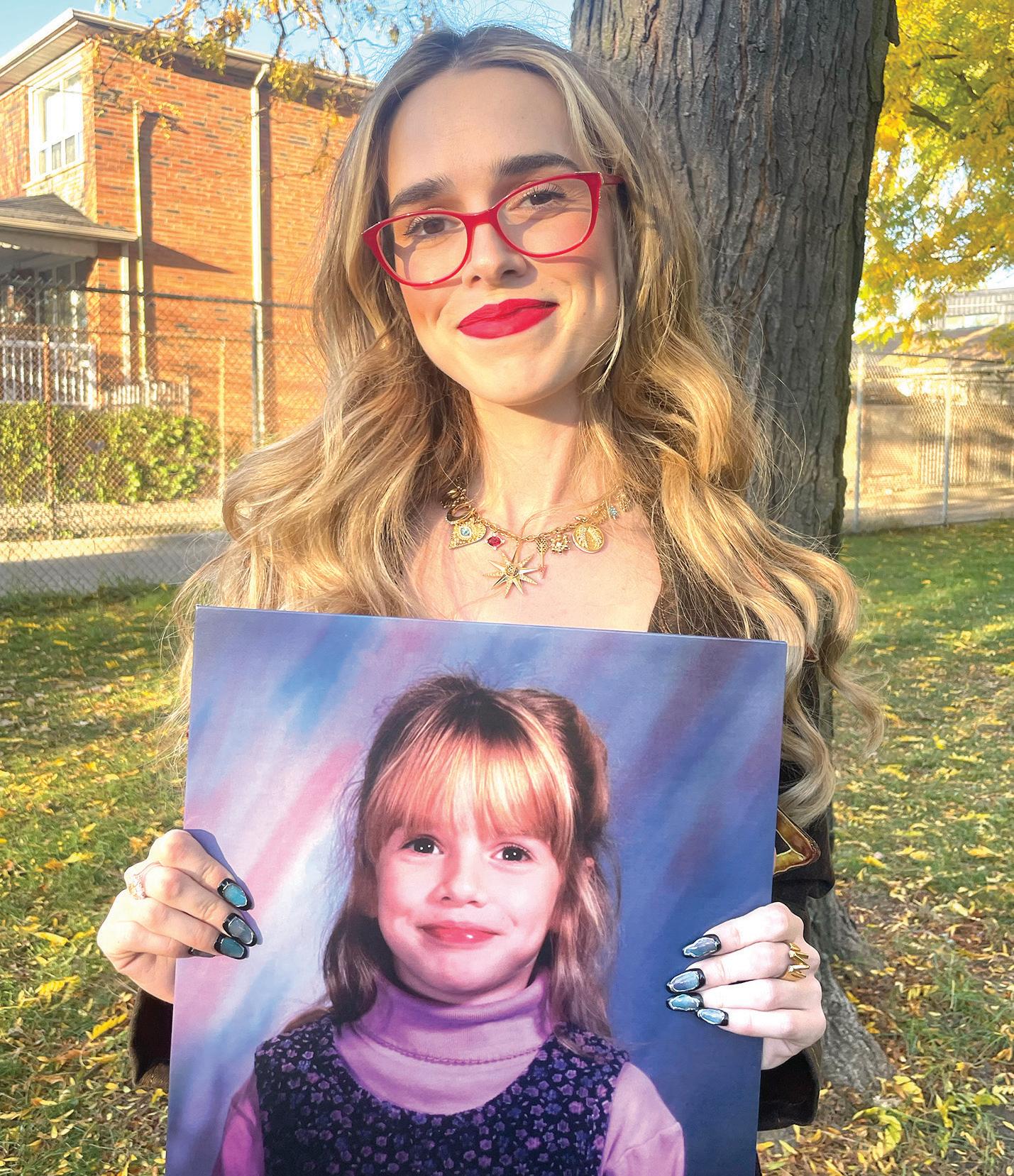


By Fred Sherwin
The Orléans Star
In Canada, Remembrance Day is reserved for the men and women who served and died in the five major conflicts the country has participated in – the Boer War, the First World War, the Second World War, the Korean War and the Afghanistan War – as well as the thousands more who served and have since passed.
But we often forget that soldiers aren’t the only casualties of war. During the Second World War, 390,000 civilians, many of them children, died in France alone. That’s more than five times the number of civilian casualties in Great Britain.
When the Germans first launched their offensive into the northern and eastern parts of France in May 1940, it sparked a mass exodus of refugees fleeing the advancing forces. An



estimated 8-10 million refugees fled their homes in an effort to escape the Nazi invasion – almost a quarter of the French population at that time.
Among the millions of refugees was former Orléans resident Miza Davie.

Born Mireille Bosc, Miza was just six years old when the Germans invaded France. As the German army approached Paris, Miza escaped to Marseilles with her mother Paule and younger siblings Robert and Françoise who were four and two respectively. It didn’t take long for the Germans to complete their invasion of France.
Miza’s mother, who was a radio personality in Paris
before the war, was forced by the Nazis to broadcast propaganda.
For the better part of two years, Miza and her siblings were raised by their grandparents – first in Nimes in the south of France and then in Générac near Bordeaux.
Later in the war, they were reunited with their mother in Paris before fleeing to an uncle’s place in the north to escape the bombing of the French capital by the Allies leading up to Normandy landings on D-Day and France’s eventual liberation.
After immigrating to Canada in the 1950s, Miza began writing a collection of short stories about her life growing up during the war. Prior to her passing in 2005, those stories were assembled in a self-published book entitled “A Child’s Memory of the Second World War”.
CONTINUED ON PAGE 10



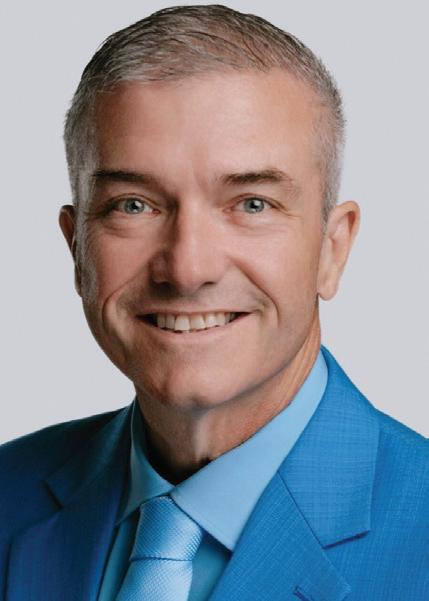


(The following story first appeared on OrleansOnline.ca on Nov. 11, 2009.)
Irving Farmer (I.F.) Kennedy grew up in Cumberland Village during the Great Depression. He was the son of Robert James (R.J.) Kennedy from Orléans and Eva Kennedy (née Farmer), originally from Blackburn.
R
.J. Kennedy was among the first volunteers who signed up to serve with the Canadian Expeditionary Force. He arrived in Europe as a member of the Royal Canadian Artillery in August 1914 and saw action in every major battle of the war, including Vimy Ridge. He was eventually injured during the Battle of Passchendaele in August 1917 and returned home to Cumberland where he and Eva started a family together.
I. F. Kennedy was the second of six kids. When he was born, the doctor described him as a “big buster” of a boy. The nickname was shortened to “Bus” and his family and childhood friends would call him that for the rest of his life.
The Second World War was already into it’s fifth year when Bus followed in his father’s footsteps and volunteered to serve, but not in the army. Maybe it was a result of hearing his father’s stories about the First World War, or maybe it was his fascination with air flight, but for whatever reason he volunteered to serve in the Royal Canadian
Air Force.
He joined the fray in August 1944 as a relative greenhorn and ended it as a seasoned veteran having flown 329 missions as a Spitfire pilot and twice earning the Distinguished Flying Cross.
Kennedy, who was given the nickname “Hap” by his fellow pilots, first saw action flying Kitty Hawks and Spitfires over Northern France before he was assigned to an RAF Spitfire Squadron in Malta in December, 1942. In early 1943, he flew operations over Sicily and Italy and later joined the 401 Squadron which saw action over Northern France following the invasion of Normandy.
It was with the 401 that Kennedy eventually rose to the rank of Commanding Officer. He was one of Canada’s most successful flying aces with 10 solo and five shared aircraft destroyed. He was eventually shot down on July 26, 1944, the victim of either an extremely accurate German antiaircraft gunner, or an extremely lucky one.
During an interview with Orléans Online in 2009, Kennedy, who was 87 at the time, still remembered every tussle he ever had as if it happened only yesterday and he still remembered the aircraft that helped him compile such an exemplary combat record and guided him through the conflict with nary a scratch to show for it.

Others were not so fortunate, however, including Kennedy’s own brother Carleton “Tot” Kennedy who died on Aug. 30, 1944 when the Halifax bomber he was assigned to, crashed just metres from the runway while returning from its first mission.
On at least four occasions during the war, Kennedy found himself locked in one-onone combat with the commanding pilot of the aircraft he and his squadron encountered. It was during those rare occurrences when the capabilities of man and machine were stretched to the limit.
During these one-on-one encounters, the German pilots were well aware of the Spitfire’s ability to make a tighter turn in a shorter radius than either the Messerschmitt 109, or the Folke-Wolfe 190 which had a faster rate of roll and could manage a “flick” turn. With that knowledge they often would fly past a Spitfire and employ a maneuver by which they would go into a series of shallow dives at full throttle, zoom upwards and then do a flick turn to come head on at the Spitfire.
The two pilots would then get off a short burst with their machine guns before passing within 20 to 25 feet of each other. As the German pilot tried to repeat his maneuver, the Spitfire pilot would immediately pull his aircraft hard to the left or right to do a 180-degree turn in as short a radius as possible in order to come around for another


go at it.
Often the Spitfire pilot would lose his vision in the middle of the turn as a result of the G-force, only to regain his sight at the end of the turn in time to catch a glimpse of the enemy and adjust his flight path accordingly. Each encounter would last six or seven minutes and involve several passes.
On those occasions when Kennedy was involved in a one-on-one dog fight, they all ended in a draw with the other pilot
CONTINUED ON PAGE 12


Continued from page 8
Here one of those stories about how she and her siblings were forced to flee Nimes and travel to her paternal grandparents home in Générac.
The Second World War was entering the second year of fighting. There were more and more refugees (mothers and children) in France. Food was becoming the number one topic of conversation. Mothers were faced with making a meal from nothing and using lots of imagination.
Out of desperation my mother invented the bread soup. We were refugees in Marseille, the four of us. My mother, my sister, my little brother and I were living in a two-bedroom apartment. To this day, I remember the aroma and taste of the “bread soup”. Cloves of garlic were cut into small
pieces and placed in an old cast iron pot with pieces of an old limp carrot and some olive oil. This mixture was cooked until the garlic pieces became dark brown and the aroma made us practically salivate.
Next, water was added with salt and pepper. The broth was heated to the boiling point. This filled the two rooms with a thin mist floating around us. As the eldest child, I was in charge of breaking small, even pieces of the dark, heavy, irregular ball which was our bread – four or five pieces into each soup bowl.
Mother then filled each bowl with three or four ladles of this bouillon. Suddenly, the dark pieces of bread would start to emerge from the bottom of the soup bowl and break into even smaller pieces. Finally, we were allowed to sit down and take our first tablespoon of mother’s miracle soup, and we could also warm our hands on the
hot soup bowls.
As we ate, there was silence in the room, except only for the noise of the spoons clicking against the bowls. My feet suddenly started to warm up, and the tips of my fingers became red with a burning sensation. The tears would run down my face with joy.
My mother had been a music and piano teacher all her life. This story takes place near the end of the war in Paris.
It was a nice sunny morning in May. There were a few white clouds floating by in the blue sky. Suddenly, the sirens began to ring, sending screeching sounds all over the city and everyone in the house began trembling with terror.
That day we did not want to go to the bomb shelter, filled as it was with water and rats. Instead my sister, my little brother and I hid
under our mother’s massive Steinway grand piano. We curled up into balls amongst the fruit and vegetables which were stored there like a marketplace.
My mother – very pale, emaciated, dressed in an old flower dress – proceeded to sit at the piano. Within seconds, her skinny fingers travelled over the keyboard, producing the most fabulous sound. She was playing “Für Elise” by Beethoven. The music started to overpower the sound of the air raid sirens. Slowly we relaxed and stopped shaking. I could not believe that classical music could be so powerful and great.
Why do we have wars that destroy the sound of peace and make children so unhappy and insecure?
Each time I listen to music, my heart says thank you to my mother and to the music composers have written, which brings so much happiness into the world.

Continued from page 9
inevitably giving up first.
“It was exhausting work. You’re going full out. You’re soaking wet from the sweat. You’re blacking out and you’re just beating the hell out of your aircraft,” said Kennedy. “On your way past, you’d give the guy a squirt and then turn as hard as you could. It wasn’t a thing for sissies. One mistake and you had it.”
Kennedy said he was fortunate and proud to have flown Spitfires calling them the envy of every Allied pilot.
On the one and only occasion he got shot down, he was leading a patrol near Paris when his Spitfire got hit by three rounds of anti-aircraft flak. The plane immediately lost power and the engine started to smoke when his wingman Bill McRae from Ottawa, yelled at him to get out.
“He just yelled, ‘You’re on fire, boss. Get
out!’,” recalled Kennedy some 59 years later. “He didn’t have to tell me twice.”
After safely parachuting out of his plane, Kennedy managed to elude capture with the help of the French Resistance known as the Maquis. He eventually came across a pair of American soldiers and later returned to England where he learned about his brother’s death. Despite applying to resume his command of 401 Squadron, Kennedy was sent home on compassionate grounds.
After the war, Bus Kennedy, earned his medical degree and became Dr. I.F. Kennedy.
He returned to his native Cumberland Village where he established a practice and delivered over 100 babies before retiring in the late 1960s.
Bus and his wife Fern spent their remaining years at their “Chickadee Woods” home just outside Cumberland Village until he passed away on Jan. 6, 2011 at the age
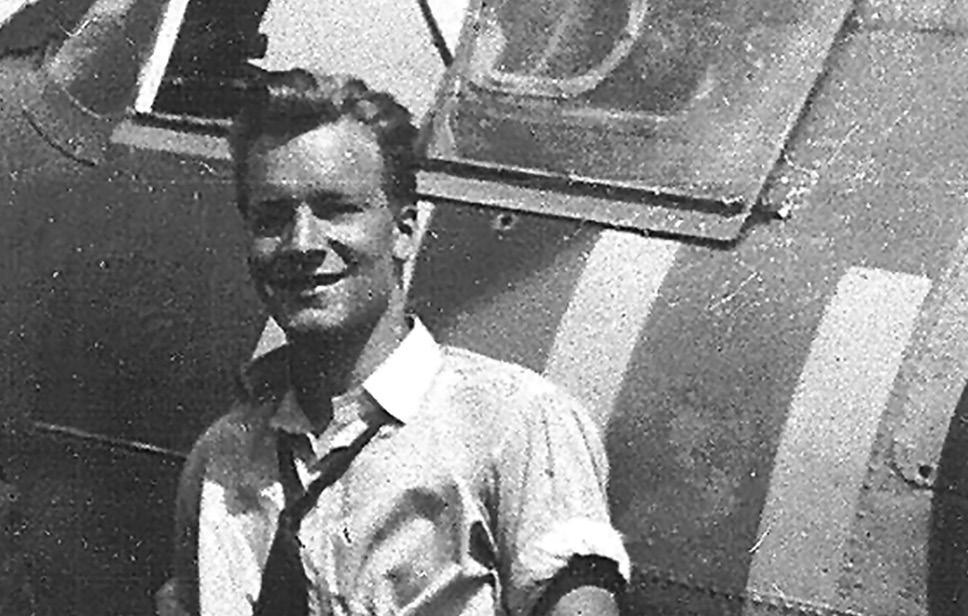
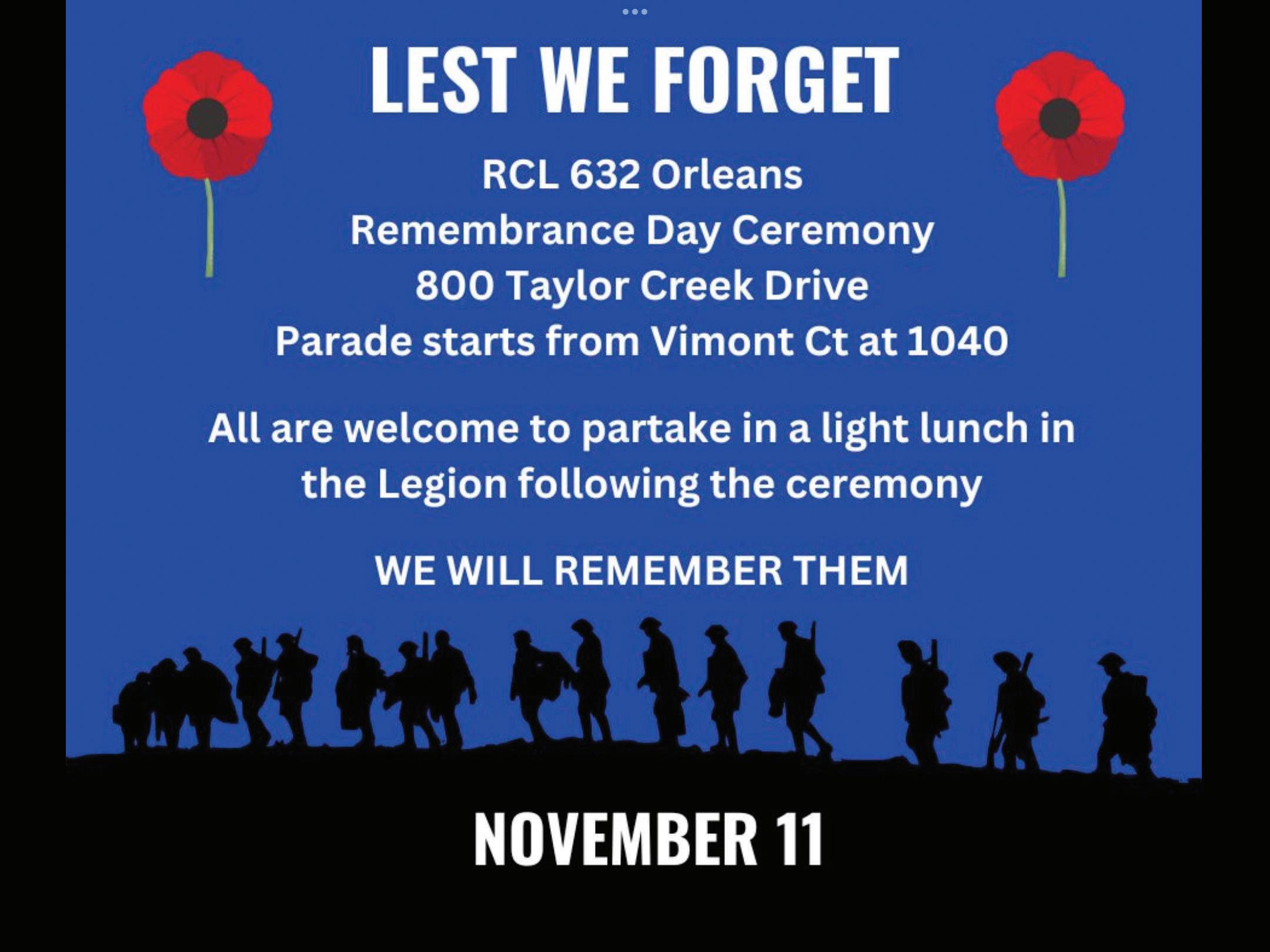






Organizers of the Orléans Legion Poppy Campaign were joined by local dignitaries for the launch of this year’s campaign at Place d’Orléans last Friday. Poppy kiosks can be found at the Walmart store on Innes Road, and the Costco Business Centre. Funds raised through poppy donations are used to support veterans and their families. FRED SHERWIN PHOTO

































Club Richelieu Orléans

By Fred Sherwin The Orléans Star
The Club Richelieu Orléans was founded in 1972 by Dr. Pierre Soucie, who is now an honourary life member and still regularly participates in the club’s activities.
The Club Richelieu Orléans is a member of Richelieu International whose founding dates back to 1944. The primary activity of Richelieu International and its member clubs is to serve the francophonie and youth through “social, educational, cultural, non-partisan political and economic actions”.
Prior to the COVID pandemic, the Richelieu Orléans Club organized regular fundraising events, the most well-known and popular of which was their annual lobster dinner which raised over $12,000 per year and allowed the club to distribute more than
$200,000 in donations in the community.
During the pandemic, the club’s activities were greatly curtailed and many of its fundraising events had to be canceled never to return, including the lobster dinner.
Since the pandemic ended, the club has become involved with the Lola Charitable Gaming Association with members volunteering a few hours a week as attendants in a bingo hall, which allows them to continue to raise significant amounts of money.
Fifty years ago, the average age of the club’s members was under 40. Today, the average age is around 60, but this hasn’t taken away from their joie de vivre and Francophone pride and their ability to raise money to help others.
In addition to awarding scholarships to French-language high
schools, the club has, among other things, made donations to food banks, Solidarité Jeunesse, the Miriam Centre, which provides pregnancy care for those who find the circumstances surrounding their pregnancy difficult, the Conseil des écoles catholiques du Centre-Est Foundation and the Coopérative Ami Jeunesse which provides food security for young people attending French-language schools in Ottawa.
The Richelieu Orléans Club has been able to renew itself and adapt to changes since the pandemic under the guidance of strong leadership, including that of its current president Louise Nadon.
For any questions or to join the club, you can contact the club’s secretary Paul Bard at paulbard@ rogers.com.




Environmental Assessment of the Proposed Waste Connections of Canada Inc. Navan Waste Recycling and Disposal Facility Landfill Expansion
Waste Connections of Canada Inc. (WCC) is beginning an environmental assessment under the Environmental Assessment Act for an expansion of the Navan Waste Recycling and Disposal Facility (the Navan Facility or the Site) landfill in the City of Ottawa.
The Navan Facility provides a wide range of waste management services including processing materials for recycling, treating contaminated soils, hosting household hazardous waste day events, and the final disposal of solid non-hazardous municipal waste and asbestos waste, excluding putrescible waste. The Site is located in the eastern end of Ottawa at 3354 Navan Road, and most of the waste handled at the Site is generated within the City of Ottawa and neighbouring municipalities. The Site is a 92.85-hectare waste management facility that includes a 40-hectare landfill with an approved landfilling capacity of 7,600,00 cubic metres. The Site has been in operation since 1960 and was previously approved for an expansion under the Environmental Assessment Act in August 2007. In April 2009, WCC received Environmental Protection Act approval for the expansion of the Navan Facility. It is currently estimated that the Site could reach capacity in 2027.
This Environmental Assessment process pertains to the expansion of the Navan Facility landfill. WCC has identified an opportunity to continue providing residual waste disposal capacity for Industrial, Commercial, and Institutional (IC&I) generators of solid non-hazardous municipal waste by development of additional disposal capacity at the Navan Facility. For the proposed expansion, the target additional airspace is 3 to 4 million cubic metres.
This study will be carried out according to the requirements of the Environmental Assessment Act. The first step of the process is the preparation of a terms of reference. The terms of
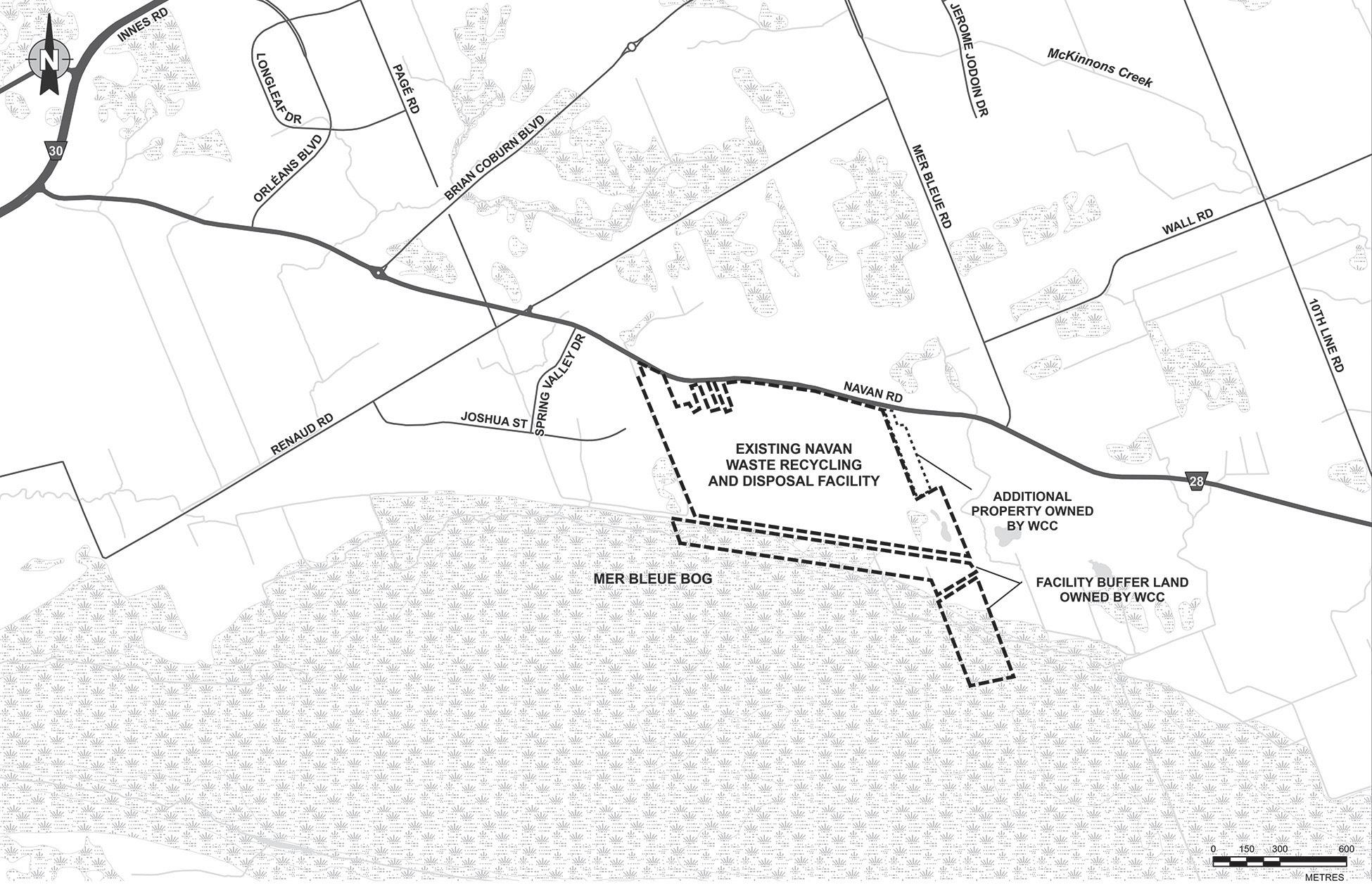
reference will set out WCC’s framework and work plan for addressing the Environmental Assessment Act requirements when preparing the environmental assessment, including the alternatives that will be considered and the public consultation activities that will be carried out. If approved by the Minister of the Environment, Conservation and Parks, the terms of reference will provide the framework and requirements for the preparation of the environmental assessment.
Members of the public, Indigenous communities, agencies, and other interested persons are encouraged to actively participate in the planning process by attending consultation opportunities or by contacting staff directly with comments or questions. Consultation opportunities, including two open houses, are planned throughout the terms of reference planning process and will be advertised in local newspapers and through the project website at www.wasteconnectionscanada.com/
ottawa-landfill/ea. For further information on the proposed study, or if you would like to be added to our project mailing list, please contact:
Chris Visser
Canadian Region Engineering
Manager
Waste Connections of Canada 6220 Hwy 7, Suite 600 Woodbridge ON L4H 4G3
Tel.: 647-539-5923
Email:
Chris.Visser@wasteconnections.com
Yannick Marcerou
Project Manager
WSP Canada Inc.
1931 Robertson Road Ottawa ON K2H 5B7
Tel.: 613-592-9600
Email: Yannick.Marcerou@wsp.com
All personal information included in a submission – such as name, address, telephone number and property location - is collected, maintained, and disclosed by the Ministry of the Environment, Conservation and Parks (MECP)
for the purpose of transparency and consultation. The information is collected under the authority of the Environmental Assessment Act or is collected and maintained for the purpose of creating a record that is available to the general public as described in section 37 of the Freedom of Information and Protection of Privacy Act.
Personal information you submit will become part of a public record that is available to the general public unless you request that your personal information remain confidential. For more information, contact the Ministry of the Environment, Conservation and Parks (MECP) Freedom of Information and Privacy Coordinator.
November 6, 2025
Veuillez noter qu’il vous est possible de nous communiquer vos commentaires ou vos questions sur le projet en français en les adressant à Yannick Marcerou au 613-5929600 ext. 3318 ou par courriel à Yannick.Marcerou@wsp.com
SATURDAY, NOV. 8
SDBC TAPROOM CONCERT
SERIES presents Redial live and in concert from 7-9 p.m. at the Stray Dog Brewing Company, 501 Lacolle Way in the Taylor Creek Business Park. Advance tickets $10 available at straydogbrewing.ca.
DARTS ARE BACK AT THE ROYAL OAK PUB from 11 a.m. to 5 p.m. All skill levels are welcome!! Teams are picked at random based on averages and the format is 501! The cost is$15/ player with all funds returned in prizing! Registration is from 11 a.m. to 11:30 a.m., games start at noon!
TUESDAY, NOV. 11
ANNUAL REMEMBRANCE DAY CEREMONY 11 a.m. at the Orléans Cenotaph beside the Orléans Legion Branch 632, 800 Taylor Creek Drive. Sandwiches
and desserts following the ceremony inside the Legion.
TRIVIA NIGHT from 7:30 p.m. every Tuesday night at the Royal Oak Pub, 1981 St. Joseph Blvd. at Jeanne d’Arc. Free to play. Prizes for the winning team! For more info visit facebook.com/ RoyalOakPubsOrleans.
WEDNESDAY, NOV. 12
OYSTER NIGHT every
Wednesday from 6-9 pm at the Orléans Brewing Co. Two types of oysters served with lemon, Tabasco sauce, horseradish, salt and mignonette. The Orléans Brewing Co. is located at 4380 Innes Rd., next to McDonalds.
THE ROTARY CLUB OF ORLEANS is hosting a Holiday Dinner at the St. Elias Banquet Centre, 750 Ridgewood Ave. Tickets: $75/person. 4 course
dinner (choice of turkey, salmon or vegetarien), dessert and punch. Contact Mashooda Sayed at mashoodasyed@yahoo.ca or call 613-255-0872.
SATURDAY, NOV. 15
CRAFT AND BAKE SALE
from 9 a.m. to 3 p.m.at the Hobbs Seniors Club, 109 Larch Cres. (off Champlain Street).
ORLEANS UNITED CHURCH CHRISTMAS
BAZAAR from 9 a.m. to 2 p.m. at 1111 Orleans Blvd. This popular event features unique handcrafted items, including holiday ornaments, toys, winter knits, and other original crafts, plus gently used books and puzzles, baking, freezer meals and silent auction. Free admission and lots of free parking.




